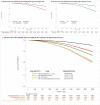Additive interaction of mid- to late-life depression and cerebrovascular disease on the risk of dementia: a nationwide population-based cohort study
- PMID: 33726788
- PMCID: PMC7968260
- DOI: 10.1186/s13195-021-00800-z
Additive interaction of mid- to late-life depression and cerebrovascular disease on the risk of dementia: a nationwide population-based cohort study
Abstract
Background: Dementia is a progressive neurocognitive disease with a substantial social burden. No apparent breakthroughs in treatment options have emerged so far; thus, disease prevention is essential for at-risk populations. Depression and cerebrovascular disease (CVD) are independent risk factors for dementia, but no studies have examined their interaction effect on dementia risk. This study aimed to identify the association of depression and CVD with the risk of dementia and evaluate whether dementia risk among patients with comorbid depression and CVD is higher than the sum of the individual risk due to each condition.
Methods: A population-based cohort study was conducted to analyze the Korean National Health Insurance Service-National Sample Cohort data of all individuals over 50 years of age. Individuals who had not been diagnosed with dementia at baseline were included and followed up from January 1, 2005, to December 31, 2013. A time-varying Cox proportional hazard regression model adjusted for potential confounding factors was used for the analysis. The interaction between depression and CVD was estimated based on the attributable proportion (AP), relative excess risk due to interaction (RERI), synergy index (SI), and multiplicative-scale interaction.
Results: A total of 242,237 participants were included in the analytical sample, of which 12,735 (5.3%) developed dementia. Compared to that for participants without depression or CVD, the adjusted hazard ratio for the incidence of dementia for those with depression alone was 2.35 (95% confidence interval [CI] 2.21-2.49), CVD alone was 3.25 (95% CI 3.11-3.39), and comorbid depression and CVD was 5.02 (95% CI 4.66-5.42). The additive interaction between depression and CVD was statistically significant (AP-0.08, 95% CI 0.01-0.16; RERI-0.42, 95% CI 0.03-0.82; SI-1.12, 95% CI 1.01-1.24). The multiplicative interaction was significant too, but the effect was negative (0.66, 95% CI 0.60-0.73).
Conclusions: In this population-based nationwide cohort with long-term follow-up, depression and CVD were associated with an increased risk of dementia, and their coexistence additively increased dementia risk more than the sum of the individual risks.
Keywords: Additive interaction; Alzheimer’s disease; Cerebrovascular disease; Cohort study; Dementia; Depression; Nationwide population; Risk factors.
Conflict of interest statement
The authors declare that they have no competing interests.
Figures


Similar articles
-
Effect of depression and diabetes mellitus on the risk for dementia: a national population-based cohort study.JAMA Psychiatry. 2015 Jun;72(6):612-9. doi: 10.1001/jamapsychiatry.2015.0082. JAMA Psychiatry. 2015. PMID: 25875310 Free PMC article.
-
The risk for future cerebrovascular disease in pregnant women with Moyamoya disease: a nationwide population-based study in South Korea.BMC Pregnancy Childbirth. 2022 May 24;22(1):433. doi: 10.1186/s12884-022-04718-8. BMC Pregnancy Childbirth. 2022. PMID: 35610618 Free PMC article.
-
Effects of depression and cognitive impairment on increased risks of incident dementia: a prospective study from three elderly cohorts.Transl Psychiatry. 2024 Oct 8;14(1):427. doi: 10.1038/s41398-024-03125-1. Transl Psychiatry. 2024. PMID: 39379348 Free PMC article.
-
Depression, stroke, and dementia in patients with myocardial infarction.Dan Med J. 2018 Apr;65(4):B5423. Dan Med J. 2018. PMID: 29619929 Review.
-
Does depression increase the risk of dementia? Updated meta-analysis of prospective studies.Actas Esp Psiquiatr. 2020 Jul;48(4):169-80. Epub 2020 Jul 1. Actas Esp Psiquiatr. 2020. PMID: 32920782
Cited by
-
The role of type 2 diabetes in the association between habitual glucosamine use and dementia: a prospective cohort study.Alzheimers Res Ther. 2022 Dec 13;14(1):184. doi: 10.1186/s13195-022-01137-x. Alzheimers Res Ther. 2022. PMID: 36514123 Free PMC article.
-
The enigma of vascular depression in old age: a critical update.J Neural Transm (Vienna). 2022 Aug;129(8):961-976. doi: 10.1007/s00702-022-02521-5. Epub 2022 Jun 15. J Neural Transm (Vienna). 2022. PMID: 35705878 Review.
-
Joint association of antioxidant intakes from diet and supplements and sedentary behavior with all-cause and cardiovascular disease mortality among US adults.BMC Public Health. 2025 Feb 12;25(1):577. doi: 10.1186/s12889-025-21725-4. BMC Public Health. 2025. PMID: 39939851 Free PMC article.
-
Have We Been Underestimating Modifiable Dementia Risk? An Alternative Approach for Calculating the Combined Population Attributable Fraction for Modifiable Dementia Risk Factors.Am J Epidemiol. 2023 Oct 10;192(10):1763-1771. doi: 10.1093/aje/kwad138. Am J Epidemiol. 2023. PMID: 37326043 Free PMC article.
-
The Vulnerability Index: A weighted measure of dementia and cognitive impairment risk.Alzheimers Dement (Amst). 2021 Dec 9;13(1):e12249. doi: 10.1002/dad2.12249. eCollection 2021. Alzheimers Dement (Amst). 2021. PMID: 34938851 Free PMC article.
References
Publication types
MeSH terms
LinkOut - more resources
Full Text Sources
Other Literature Sources
Medical

